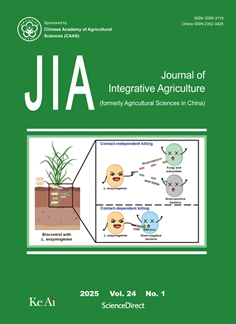
From today, our special five-part series, "Raymond's Xinjiang Stories", takes you inside one of China's most dynamic regions. The first topic is cotton. Xinjiang is China's cotton heartland, producing more than 90 percent of the nation's crop. But beyond sheer volume, smart technology is transforming every stage of the supply chain. Ray Addison looks at how cotton is being reimagined from field to factory.
RAY ADDISON Xinjiang Uygur Autonomous Region "Cotton has long been a cornerstone of Xinjiang's agriculture, labor-intensive, yes, but economically vital. Now, with the rise of smart technology, production is becoming more efficient. Greater returns appear to be on the horizon for those working in the fields."
At a test site in Changji Prefecture, a team from the Western Agricultural Research Center is trialling new cotton varieties to create higher-yields.
Smart sensors continuously monitor soil and canopy temperatures while autonomous drones monitor the fields, scanning for crop vigour, pest volume, and moisture status.
At the same time, robots patrol the ground.
RAY ADDISON Xinjiang Uygur Autonomous Region "This handy bit of kit behind me is Chinese made, Chinese designed and they're using it to monitor the 400 different varieties of cotton which exist in these gorgeous fields which exist all around me now. It measures a number of things, the height of the plant, the temperature, the levels of chlorophyll, and then researchers use that data to recommend to local farmers which cotton plants they should use."
On-site training is also provided to local farmers on how to use the new technology.
MENG YONGMING General Manager, Xinjiang Union Youmian Technology Service "Last year, the number of trainees we officially recorded was about five to six thousand, but if we include people who came on their own, without prior notice, to observe and learn, there were more than twenty thousand."
Adoption has been swift. Where one farmer once managed around seven hectares of cotton, with intelligent irrigation and pest-control systems, the same farmer can now manage more than double that area.
SONG MEIZHEN Researcher, Institute of Cotton Research, Chinese Academy of Agricultural Sciences "Because these smart technologies are still new, full-scale adoption will take a few more years. Yet the current level of smart farming is already in place: with my phone I can open or close smart valves whenever I want, irrigating or fertilizing on demand. Many large growers are already using this, and acceptance is very high."
Meanwhile researchers say, despite smart tech making work easier – employment opportunities will always exist.
SONG MEIZHEN Researcher, Institute of Cotton Research, Chinese Academy of Agricultural Sciences "Some worry that if everything becomes smart and autonomous many workers will be left without jobs or income. In reality, that is not the case. Even in smart farms people are still needed for management, maintenance, calibration and other tasks; the workforce is smaller, but it remains essential."
Xinjiang's modernization story doesn't stop at the field. At a nearby factory, cotton stalks, once discarded or burned, are being broken down and turned into valuable new products through a new process of steam-explosion.
CHEN JUN Chairman, Xinjiang Xuze Biotechnology "This is our core unit. Every explosion batch is 350–400 kg. The bags are slit open, the material drops onto the belt, and the belt feeds it into the explosion chamber. One batch is roughly 400 kg, and after a few minutes of holding pressure, we achieve a successful explosion."
The stalks are blasted with steam at nearly 190 degrees. The sudden pressure drop shatters the cell walls, unlocking hidden nutrients.
The resulting product can be used as a protein-rich feed for cattle or something even more groundbreaking to heal the land itself.
CHEN JUN Chairman, Xinjiang Xuze Biotechnology "For ecological restoration, steam-exploded cotton stalks yield pectin and fructose in addition to the three main fractions. In the field, the pectin and fructose quickly form a surface crust that fixes drifting sand while simultaneously supplying nutrients and moisture to germinating plants."
At a nearby test site we can see the results. Once completely barren with saline-alkali soil, plants are now growing thanks to the material's ability to retain water.
CHEN JUN Chairman, Xinjiang Xuze Biotechnology "This is one of our test plots. When we started, it was completely barren, with a pH around 8.7, true saline–alkali soil. After we covered it with our material, you can see how well the plants are now growing, thanks to the material's excellent water-retention capacity."
"The earth's quite spongy as well."
"Yes, exactly, look how well it's holding the moisture."
"You can see here how all the stalks are really binding together to hold that ground together. We've got the dry surface, and then the moisture of the ground underneath. And, of course, it's the perfect environment for these plants to sprout here and hold it all together, fantastic!"
With a daily capacity of around 40 tonnes, this factory can produce more than 10,000 tonnes a year. However, plans are underway to scale-up production.
CHEN JUN Chairman, Xinjiang Xuze Biotechnology "Our plan is to roll out another 15-20 identical plants across Xinjiang so that we can utilize the region's crop residues as much as possible, meeting the growing demand from both its livestock sector and its environmental-restoration programs."
Xinjiang's cotton story is no longer just about scale, it's about transformation. From smart drones above the fields to steam reactors inside the factory, this is agriculture rewritten for a new era. And in the process, Xinjiang's farmers are seeing the benefits first-hand.







